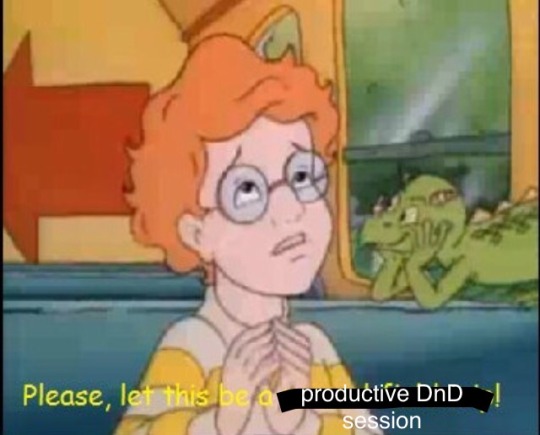Text
elemental resistances in bio or I block
37K notes
·
View notes
Text
short dm tip for making your world feel more ‘lived in’ - no place is stagnant. when your players return somewhere, make some aspect different. there’s a carnival in town, an npc got married/got a haircut/got a cat, beasts have come through and wrecked the place. it makes the world feel ‘realistic’ (or as realistic as our wizard bullshit can feel), like people don’t just wait for your players to come around before they live their lives, and keeps your nerds on their toes!!
248 notes
·
View notes
Text
one of my fave DnD things is how, during character creation, people start talking in first person without realising. they start out like ‘well, she’s a paladin’ and within ten minutes their fists are clenched as they shout ‘MY SISTER DESERVED WHAT SHE GOT AND IF YOU DISAGREE I’LL KILL YOU TOO’
48K notes
·
View notes
Text
More dumb magic items for your D&D campaign:
A sword that inflicts emotional wounds
A hat that, when left alone with another hat, will mate and produce hybrid offspring
Negative gold pieces
A map that is the territory
Armour that becomes more effective the uglier the wearer
A living pocket-watch that never needs winding, but if you don’t feed it, it dies; it’s an obligate carnivore
Goggles that put censor bars over monsters of the Aberration type
An instructional tome in the secret language of ducks
A dagger that glows in the presence of one particular goblin
Angry shoes
70K notes
·
View notes
Photo

Dracotaur Large monstrosity, neutral evil Armor Class 15 (natural armor) Hit Points 51 (6d10 + 18) Speed 50 ft. Str 18, Dex 12, Con 16, Int 13, Wis 11, Cha 13 Senses darkvision 60 ft. passive Perception 10 Languages Draconic Challenge 3 (700 XP) Magic Resistance. The dracotaur has advantage on saving throws against spells and other magical effects. Actions Multiattack. The dracotaur makes two melee attacks, each one with a different weapon. Bite. Melee Weapon Attack: +6 to hit, reach 5 ft., one target. Hit: 7 (1d6+4) piercing damage. Spear. Melee Weapon Attack: +6 to hit, reach 10 ft., one target. Hit: 11 (2d6+4) piercing damage. Tail Slap. Melee Weapon Attack: +6 to hit, reach 5 ft., one target. Hit: 6 (1d4+4) piercing damage. If the target is Medium or smaller, it must succeed on a DC 14 Strength saving throw or be knocked prone. Spit Fire (Recharge 6). The dracotaur exhales fire in a 20-foot cone. Each creature in that area must make a DC 13 Dexterity saving throw, taking 18 (4d8) fire damage on a failed save, or half as much damage on a successful one.
Dracotaurs are nomadic beings that wander through marshes and fens, living in small tribes of thirty to fifty members. They worship might and arcane power above all else, and to them there is no great embodiment of these ideas than the true dragons. Tribes sometimes fight over land or food but more often will band together if a threat arises. They sometimes ally with lizardfolk and other reptilian creatures, though they are distrustful of others. Dracotaurs rarely build settlements, preferring to remain on the move, but might use ruins as shelter or as a neutral meeting place for several tribes. They stand around 7 feet tall and 10 feet long, weighing around 2000 pounds. Hard scales cover their bodies, ranging from dull green to light brown, and males have crests running along their backs that can be reddish or purple.
Originally from the Monster Manual III. A request from dukebadham. If there is a monster from 3.5 or Pathfinder that you want to see converted to 5e, feel free to send me a message or submit a monster request on the submit page.
1K notes
·
View notes
Text
Dungeon Master Essentials
I decided to make a list of DM stuff that I personally use or think are important to know when it comes to being a DM. So here’s my list:
Medieval Fantasy City Generator: This generator is now my LIFE. It generates incredibly complex cities with good customization. (Thanks to plantkat for sharing this site in their post here)
Naming Your Towns/Cities: Now that you’ve made your city, time to name it and give it some character! This post contains lots of great information.
Index Cards Rule: Fuckyeahdnd shared a SUPER convenient way of keeping track of turns and HP in combat. I use this system now for every single session I run.
Tricks & Traps: I am AWFUL at coming up with good Dungeon traps and challenges, this PDF includes some incredible ideas. The original poster, Courtney C. Campbell also runs a blog where she shares tons of great stuff. (Thanks to we-are-rogue for sharing the PDF in their post here)
Playing Different Types of Characters: Writeinspiration has a masterpost on how to write/play lots of different types of characters.
Unique NPC Jobs: Lauraharrisbooks wrote a list of different Fantasy Jobs which can help populate your world with some unique characters! Another similar post by Thewritershandbook also covers Common Occupations in the Middle Ages.
Developing Characters by Threes: Monticusrex’s method of creating characters help you really flesh out who they are. Useful for Players and DM’s.
Troublesome Players? Speak Up: Dicebound brings up an incredibly great point. If someone is being a jerk, speak up and call them out. This is especially important and relevant now to crush awful behavior before it even has a chance to show it’s ugly face.
List of D&D Resources: And finally, pretty much anything you might need for D&D. (Character stuff, spells, online communities/ways to play, etc..) A lot of people contributed to this post but thank you Mushroomancy for posting the original list.
Donjon: And finally, this site is a great resource for looking up Spells and Monsters along with tons of other generators. Not every single Spell or Monster is on here, but most are listed.
(I tried to give credit to the original posters or the actual URL for websites, unless those sites or URLs were no longer active)
53K notes
·
View notes
Text
Do you think wizards in the d&d world are super salty about bards? Like, you spend decades and decades researching magic at the finest institutions across the lands so you can make fire and conjure ice, and then along comes some random asshole who wanders tavern to tavern telling suggestive folk tales and conning the villagers, some unkempt bastard who can sing so goddamn righteously that they also control minds and teleport places and bend time and fucking space to their will thanks to just a really well-placed A-sharp
11K notes
·
View notes
Text
Why is it that in almost every D&D group I’m in, SOMEONE wants to have a joke character. And no, I don’t mean like a choatic neutral bard or something, I mean a goddamn chicken. You wanna be a fucking chicken??? A CHICKEN???
I SPENT SO MANY HOURS CRAFTING HOMEBREW RACES, AND CLASSES AND SHIT AND YOU WANNA BE A NORMAL FUCKING CHICKEN WITH A BIG SWORD??? REALLY???? REALLLLYYYY????
So no, I don’t really mind bards.
45K notes
·
View notes
Text
D&D: How to Use Character Arcs as a Dungeon Master
In my previous post on character arcs, I talked about how a player should determine how they want their character’s arc to begin and end. It was from a player’s perspective. But how does a DM write an adventure that will make that player’s arc happen?
First, get the information you need. Ask your players to each determine how their characters will begin the campaign and how they want them to change by the end of it. Then ask for copies of their character’s traits, flaws, ideals, and bonds. Note whether a player’s character is going to die tragically and if they are okay with that. With this information, you can give the players what I call a moral quandary, personalized for their own character’s arc. A moral quandary is giving the player two difficult options that the player must decide how their character would choose. The character should lean to one side of a moral quandary at the beginning of an adventure, but gradually start to lean the other way as their arc comes to completion.
For instance, a cleric might be presented with a choice to kill an evildoer or merely capture them. If the cleric is heading down an arc where their ideal changes from “all life is precious” to “evil must be stopped at all costs” in their character arc is going to make very different choices in that situation depending on where they are on their arc.
Let’s figure out how we can use this info as a DM and where to put moral quandaries using a 9-point story structure. These are not an entire campaign, but you can use each point as a fixed point in the narrative; a story outline based on the characters’ arcs. Plenty of different stuff can happen between each point, but the points must happen to create a robust story.
Call to Action
The player is given an initial call to action. Essentially, a moral quandary disguised as a quest hook. Try to have a separate but related call to action for each player. Ideally, the players should refuse the call to action, as they haven’t been “changed” yet. If they play to their characters’ initial backgrounds and traits, they will refuse the call. You can even enforce this by loading your call with descriptions of how the character is feeling. “You are offended that someone would even offer something so morally reprehensible to you, despite the fact that you could use the money.”
A good-hearted rogue is starting a tragic fall arc and is offered a chance to make millions from some morally questionable actions involving an evil regime, but decides it is wrong. An innocent paladin starting a coming of age arc could be offered a chance to rise against an evil regime, but values their own safety. A studious apprentice wizard starting a corruption arc is offered power in exchange for service to an evil regime, but decides they can get power on their own.
Inciting Incident
Something happens to force the player to action, whether they are ready or not. Try to come up with an inciting incident that involves all of the players, not just one. The inciting incident can act as where the adventuring party finally meets.
The evil regime in the Call to Action ends up invading the players’ quiet suburb to enforce martial law. The players escape or fight back or else they and their loved ones die or are enslaved. The rogue decides to run from their debts by joining the party. The paladin has seen firsthand what the regime can do, and will now join the party to find someone else who can help them stop it. The wizard seeks out more power to stop the regime.
1st Plot Point
The players learn the first shreds of information about the overarching narrative of the campaign. After the inciting incident, some characters might not be convinced and want to turn back. This gives them a reason to continue onward together, as a team. There should be no turning back from the 1st plot point.
Players learn how this evil regime has been spreading across the kingdom. It still holds many mysteries, but its power is great and threatening. Its power is centered in a capital city, which the players now opt to travel to in order to find the things they currently desire.
1st Pinch Point
A pinch point is the first real display of power from the antagonist or opposing force. In D&D this should be actual combat, though it doesn’t have to be. As long as the players see firsthand what the antagonist can do to their characters, this part will add the tension/drama that it should. If you want to have a 1st Pinch Point for each character, then this display of force should directly target the player’s character arc and spark the desire to change through a moral quandary. It’s an awakening. Create tension by ending a session with this pinch point.
The players come across a thieves’ guild run by the evil regime. The rogue takes note of how rich, glamorous, and lawless the life of a criminal is to spark their tragic fall arc. The paladin realizes how deep the corruption of the world runs and sparks their coming of age arc as their innocence starts to fade. The wizard realizes how much resources the evil regime has, and wonders what sorts of power they had in mind for him sparking their corruption arc.
Midpoint
More info is revealed about the antagonist and the perception of the characters change. They have an epiphany and decide to continue onward through their arc. This can, and most likely will, happen at different times for each character and their varying arcs.
The players learn about the leader of the regime. They have been pushed to the breaking point by the regime’s forces. The rogue decides join the regime and start doing crime for the regime and acting as a double agent against the party. The paladin no longer cares about finding someone else to help them stop the regime, vowing to end it themselves. The wizard gets an unholy tome and decides to learn how to make a pact with the demon the regime mentioned to overpower the regime. They are all still heading to the capital, though now with severely divergent goals.
2nd Pinch Point
The antagonist reveals their full power and threatens the completion of the characters’ arcs. The entire party should, in general, be at their lowest moment and completely without hope. This should happen at the same time for everyone. Ideally, end a session with this pinch point to create a cliffhanger and highlight the hopelessness.
The players reach the capital of the evil regime. The rogue is faced with a moral test, where they will be offered riches and allowed to live if they rat out their adventuring party. They choose to take the offer and are betrayed by the regime’s leader and sentenced to death anyway. The paladin comes face to face with the regime’s leader after being ratted out by the rogue. They fail the encounter and barely manage to escape with their life. The wizard is also defeated and their unholy tome is destroyed in the battle. The rogue is imprisoned and the paladin and rogue escape the leader and are being hunted in the capital.
2nd Plot Point
The last piece of the puzzle has come together in the second plot point. The characters finish their arc and learn how to overcome the antagonist. This can happen at different points and doesn’t have to happen quickly. For a tragic character, this is the part where they finally meet their end. Tragic characters fail to change or their change is self-destructive and they fail to overcome the antagonist of the story (tragic, isn’t it?). Think of this part as a moral quandary that characters’ finally “know the answer” to, as far as their character arc is concerned.
The rogue tries to escape, succeeds, but heads back to the thieves’ guild instead of his adventuring allies, and they ultimately betray and kill him. The paladin’s innocence is shattered and they gather rebel forces over time to take on the regime’s leader, becoming a leader themselves. They also find an unlikely ally in the wizard, who has finally succumbed to evil. The wizard still doesn’t know how to summon the demon, but they have already gotten a taste of evil’s power by performing vile rituals on captured regime members and will now use their power for vengeance against the regime’s leader.
Climax
The characters finally face off with the antagonist. The promise set out at the beginning of the campaign is fulfilled. The characters, having completed their arcs, are now changed enough to be able to defeat the antagonist. This should be the players at their most powerful and should be the most epic battle to take place in the campaign.
The paladin’s rebel army and the wizard’s evil magic face off against the evil regime’s leader. The battle is long and epic, but the characters succeed, freeing the kingdom of the evil regime.
Resolution
The game shouldn’t abruptly end after the antagonist is defeated! There needs to be closure. The players’ characters find out the results and the aftermath of defeating the antagonist, for better or for worse. In the case of an ongoing game, you should now set up the next campaign here.
The paladin and wizard regard each other as unsteady allies who no longer have a common enemy. The wizard seeks more power, even seeking to possibly usurp the void of power left from the regime’s defeat. The paladin and their rebel army gather in defiance of the wizard. The paladin tells the wizard to leave the kingdom and not threaten anyone with their evil, else the paladin will smite them down. The wizard, not having many spells left after the battle and not being ready to face an entire army, teleports away to parts unknown with a puff of green smoke. The paladin is placed in power, and the wizard now acts as a looming threat. Perhaps an NPC and villain for the next campaign?
This character arc outline is not cut-and-dry. You should use it as a guide, not a rule. Some characters might abruptly choose to change. Some will reach different parts of the outline at different times or out of order. Some characters might waffle between two sides of their arc before deciding which side they want to be on. But the more you talk to your players about it, the easier it is to come up with a generalized plan for your campaign’s story. Heck, your story might even change from what you initially intended by the end of it (a character with a bad roll can still end up dying before even finishing their arc!) But hopefully this will aid you in making the players love their characters even more and have fun as they grow and change in your campaign’s world. That’s what it’s all about, after all.
2K notes
·
View notes
Text
know the difference
It has come to my attention that many people mistake wyverns for dragons, so here’s a post to help you remember
Dragon: 4 legs, 2 wings

Wyvern: 2 legs, 2 wings
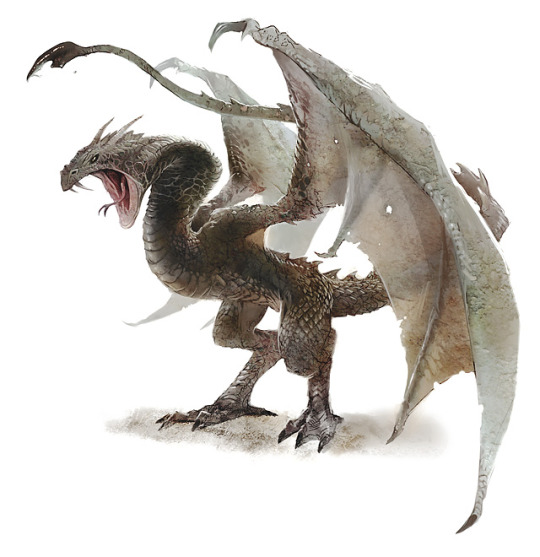
Drake: 4 legs, flightless
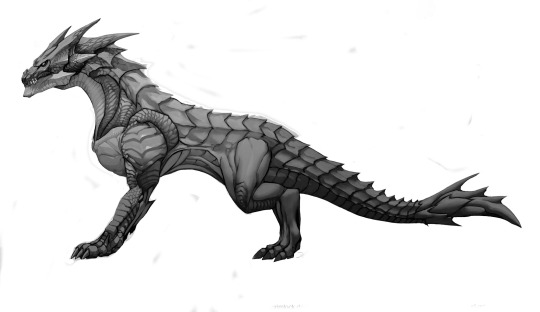
Wyrms: long snake like body with no appendages, can also appear as a traditional Chinese dragon with 4. Legs and no wings yet can fly

Amphithere: 0 legs 2 wings, can be feathered
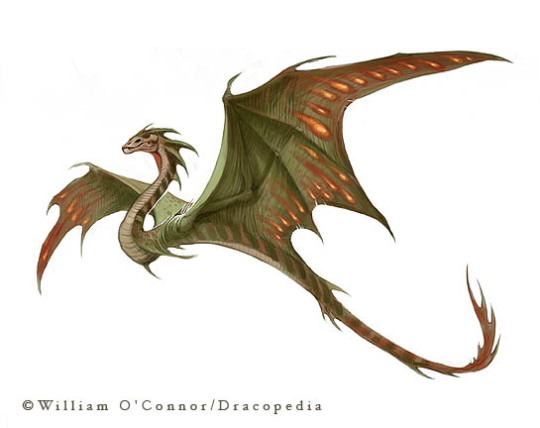
Lindwurms: 2 legs, 0 wings, long body
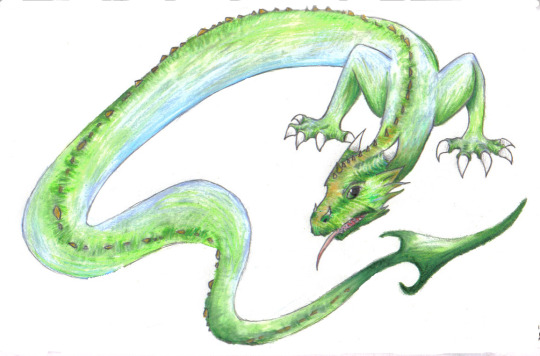
Luck dragon: 4 legs, no wings, can fly, long body, furry with dog like face

Komodo dragon: 4 legs, no wings, real

Bearded dragon: 4 legs, 0 wings, often kept as pets
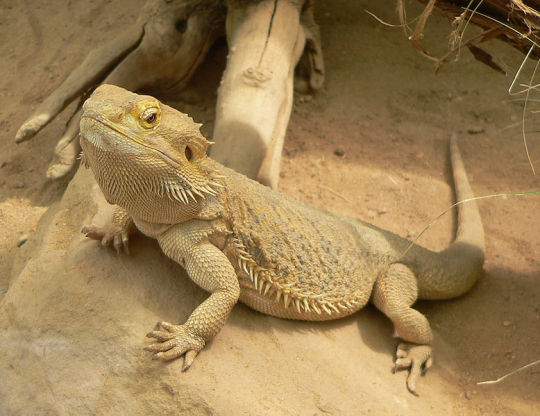
321K notes
·
View notes
Text
List of Elemental Abilities
Air/Wind
Aerokinesis -manipulate the air, wind, and gas.
Aeroportation - teleport using air/wind currents.
Air Mimicry - transform into a cloud of gas, fog, or mist.
Atmokinesis - manipulate the weather by mixing water, fire, earth, air, and lightning/electricity.
Deoxygenation - suck up all the oxygen from a place.
Lung Adaptation - breath anywhere
Wind Generation - create blasts of air.
Divine Winds Manipulation - create and control heavenly winds.
Dark Wind Manipulation - create and control eerie winds.
Earth
Geokinesis - control, manipulate, and reshape the earth at will.
Atmokinesis - control and manipulate the weather by mixing water, fire, earth, air, and lightning/electricity.
Crystallokinesis - manipulate minerals and crystals.
Ferrokinesis… manipulate metal at will.
Fraxikinesis - manipulate burnt matter.
Geo-Thermokinesis - manipulate, control, and create lava, magma and volcanoes.
Golem Creation - make golems out of inanimate materials like rocks, wood, plants, magma, etc.
Granulation… can turn things into sand.
Halokinesis - control and manipulate salt.
Hyalokinesis - control and manipulate glass.
Koniokinesis - manipulate and control dust particles.
Plassikinesis - manipulate and control all forms of plastic.
Psammokinesis - can control and manipulate sand.
Terrakinesis - control, manipulate and alter/reshape the surrounding terrain and landscape at will.
Terraportation - teleport via the earth and earth-based materials.
Sacred Earth Manipulation - Create, manipulate, control, reshape divine earth minerals.
Black Earth Manipulation - Create, manipulate and control tainted and evil earth minerals.
Fire
Pyrokinesis - create, control and manipulate fire, flame and heat.
Atmokinesis - control and manipulate the weather by mixing water, fire, earth, air, and lightning/electricity.
Fire Breath - breathe out flames.
Geo-Thermokinesis - manipulate lava, magma and volcanoes.
Heliokinesis - manipulate and control the sun and sunlight.
Hell-Fire Manipulation - Generate and control flames of hell.
Holy Fire Manipulation - Generate and control flames of Heaven.
Inflammation - burn things.
Melting - heat molecules to melt things.
Plasmakinesis - can control plasma.
Pyrotechnics - create fireworks.
Self-Detonation - explode self and reform.
Thermokinesis - create, control and manipulate heat.
Water
Hydrokinesis - manipulate and control liquid water and mold it into any desired shape or form.
Aquatic Adaptation - adapted to underwater living.
Aquatic Respiration - breathe underwater.
Atmokinesis- control and manipulate the various aspects of the weather by mixing water, fire, earth, air, and lightning/electricity.
Dehydration - absorb water.
Hydroportation - teleport across short or long distances through liquid water.
Water Mimicry - turn into liquid water.
Holy Water Manipulation - create, manipulate and control graceful waters.
Dark Water Manipulation - create, manipulate and control evil and dangerous waters.
Darkness
Umbrakinesis - can manipulate and control darkness or shadows.
Animated Shadow - Animate one’s shadow.
Light Absorption - block out light in an area.
Night Vision - see in the dark.
Sacred Darkness - create holy darkness.
Shadow Camouflage - be unseen in shadows.
Shadow Mimicry - become a shadow.
Umbrageous Teleportation - teleport via the shadows and darkness.
Electricity/Lightning
Quintessence Force -Can generate whitish-blue lightning that also contains pure life energy.
Electrokinesis - control, generate or absorb electric fields and shoot lightning bolts.
Activation & Deactivation - turn stuff on and off.
Positron Manipulation - control positrons, the antimatter counterpart to electrons.
Electrical Absorption - absorb electricity.
Electric Mimicry -transform entire body into a lightning-like being of pure electrical energy
Electrical Transportation - teleport with lightning.
Divine Lightning Manipulation - create and control the brightest lightning.
Black Lightning Manipulation - create and control the darkest lightning.
Energy
Dynamokinesis - manipulate existing energy.
Energy Blast - create blasts of energy.
Energy Emission - release energy.
Quintessence Force - create and manipulate unique form of electrical and life energy.
Mana Manipulation
Chi Manipulation
Electricity Manipulation
Energy Manipulation
Ice
Cryokinesis - control ice, snow and other forms of frozen water.
Freeze Breath - freeze things in solid ice.
Freezing - lower the temperature in kinetic atoms to freezing temperatures.
Frigokinesis - control snow either as precipitation or already on the ground.
Ice Beam - shoot beams of freezing energy.
Ice Generation
Light
Dark Light Manipulation - create the darkest light in existence.
White Light Manipulation- create sacred light from the divine.
Photokinesis - create and manipulate pure light.
Force-Field Generation - create protective shields of solid photons.
Invisibility - be unseen.
Laser Emission - bend light wavelengths to create lasers.
Light Absorption -absorb the light around you.
Light Generation - emit blinding light or glow in the dark.
Light Mimicry - take on the traits of light.
Photoportation - Teleport by using photons.
Projective Invisibility - turn other things invisible.
Evil Banish - Rid and banish all spirits of evil and black magic.
Light Manipulation
Weather
Atmokinesis - manipulate the various aspects of the weather by using water, fire, earth, air, and lightning/electricity.
Atmokinetic Resistance - immunity to all weather-based abilities and effects.
Atmokinetic Sensing - sense the future weather patterns.
Other
Aether Manipulation
Cosmic Manipulation
Gravity Manipulation
Nether Manipulation
Space-Time Manipulation
From Superpower Wikia. See their complete list of superpowers HERE.
107K notes
·
View notes
Text
Trying to write a dnd campaign
Player 1: I want to play a cleric w a really sad and dramatic backstory
Player 2: I wanna play an orc who has his dick out 100% of the time
49K notes
·
View notes


